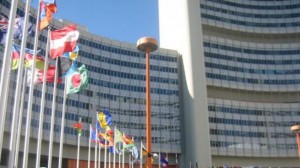 A view of the headquarters of the International Atomic Energy Agency (IAEA) in the Austrian capital of Vienna[/caption]
A view of the headquarters of the International Atomic Energy Agency (IAEA) in the Austrian capital of Vienna[/caption]Iran encouraged United Nations nuclear monitors to use powerful new detection technologies to dispel international concern that the Persian Gulf country is seeking to build atomic weapons.
The International Atomic Energy Agency�s 35-member board of governors will conclude its quarterly meeting today in Vienna without raising pressure on Iran. World powers reiterated their concerns in a statement about Iran�s nuclear program while highlighting �deep concern� about the planned startup of a plutonium-producing reactor next year.
�We always welcome the agency to have more sophisticated equipment, to have more accuracy in their measurements, so that technical matters will not be politicized,� Iranian envoy Ali Asghar Soltanieh said late yesterday in Vienna. The Islamic republic won�t object to IAEA monitors using new technologies to determine whether plutonium is being extracted from spent fuel at its new reactor in Arak.
Detecting noble gas traces left by plutonium production is as old as the nuclear age itself. During the�Cold War, the U.S. used planes and measuring stations to look for Krypton-85, the isotopes released when spent-uranium fuel is reprocessed for atomic-bomb material. Today, Krypton-85 and other gas traces are monitored by a network run by the UN�s nuclear-test-ban treaty organization.
While Iran says it has no intention of extracting plutonium from fuel, the IAEA reiterated in a report last month that they can verify Iran�s claim �only with respect� to the sites inspectors� visit. The agency, entering the second decade of its Iranian investigation, has information showing Iran may be hiding �military dimensions� to its atomic program.
Plutonium Path
�What the reactor does is create what is referred to as a plutonium path to potential weapons-grade material for a nuclear device,� U.S. IAEA envoy Joseph Macmanus said yesterday in Vienna. Iran already possess the ability to pursue a separate path toward nuclear weapons by enriching uranium.
The IAEA currently doesn�t look for noble gas traces that would indicate plutonium production in Iran or elsewhere. The agency considers detection techniques to be �novel technologies� that are being�looked into, according to its 82-page Safeguards Implementation Report published this week.
While the agency hasn�t yet tried to bolster its conclusions on plutonium processing in Iran, inspectors may begin to request noble gas data, a senior international official with knowledge of the investigation said. The official requested anonymity because of the sensitivity of the talks.
Iran�s Arak reactor will begin testing in the fourth quarter and be loaded with nuclear fuel in the first quarter of 2014. When operational, it will produce enough plutonium to produce two nuclear bombs a year, according to the Washington-based Institute for Science and International Security.
�I don�t think the U.S. has determined what the best next step would be,� Macmanus said, responding to whether a fifth Security Council report would be sought among IAEA members. �I think we have dealt with this issue and will continue to in an incremental fashion. We�ll be back here in September.�
By Bloomberg
The Iran Project is not responsible for the content of quoted articles.










